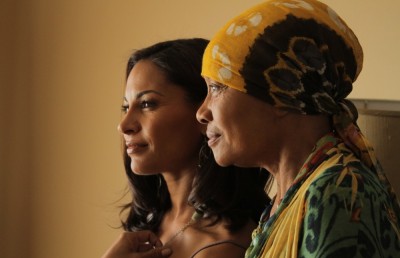Representations of Women and Veiling with the Advent of Cinema in the Middle East
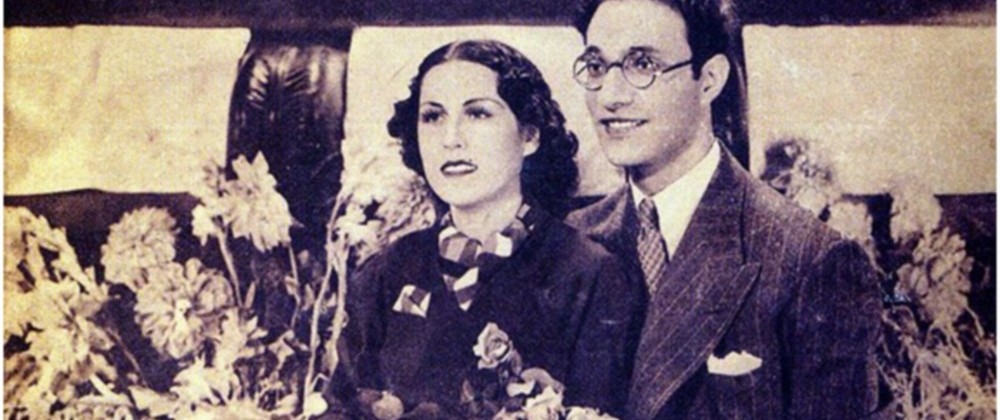
The advent of motion picture production in the Middle East gave rise to new forms of cultural representation at a time of increasing modernization in the region. Countries such as Iran and Egypt, whose film industries grew at a steady pace over the course of the twentieth century and whose output consists of the majority of films produced in the region today, saw cinema as not only a form of popular entertainment, but an opportunity to develop a national identity that could reach audiences both domestically and internationally – thus, redefine the image of one’s nation not only to local populations but to populations at large. Representations of women and the cultural and religious practice of veiling or hijab in many ways became a marker of this newly redefined national identity; one that reflected changes in the sociopolitical landscape of those years. The countries’ steady push towards sovereignty and modernity coupled with the desire to eradicate all forms of ‘cultural backwardness’, in many ways emblemized by the veil, led to the production of films that supported these efforts both in Iran and in Egypt. Women thus became important figures in early motion picture production: on a practical level as active participants both onscreen (as actors) and off screen (as producers) while in allegorical terms by serving as cultural and political representatives of the East-West encounter (Shafik 92). Using Iran and Egypt as case studies, I will examine the role of women in early motion picture production in the Middle East focusing specifically on representations of veiling in relationship to questions of how national identities were being redefined amidst Western social, economic and political influence in the region. A brief overview of the historical context surrounding the production of some of the earliest feature-length films to be produced in Iran and Egypt will serve as premise for my discussion, which aims to determine the extent to which women, as participants in these early films, embodied dichotomous cultural transformations that were reflective of the era in question. Finally, an account of some of the leading actresses and producers to have come out of early Iranian and Egyptian cinema and their influence on women’s continued participation in the film industry as well as the evolution of hijab in film will provide an understanding of the trajectory that filmmaking would take in the latter half of the twentieth century and beyond.
The early nineteen hundreds witnessed a burgeoning feminist consciousness among women in Iran and Egypt coupled with nationalist movements in both countries which women actively participated in. As early as 1905, Iranian women took to political activism by way of public protests demanding the establishment of parliamentary democracy in order to mitigate further colonization of Iran’s resources (Naghibi 29). The onset of the 1905-1911 Constitutional Revolution signified a continuation of this struggle with demonstrations organized in protest of Muzaffar Al-Din Shah’s inadequate handling of the country’s resources and ongoing dependency on foreign powers. However, the path towards a parliamentary system of governance and the creation of a constitution did not happen overnight and was tainted by violent clashes between royalists and constitutionalists throughout the country. During a ten-month siege of the city of Tabriz, the government attacked the Majlis (parliament) and civil war between both factions ensued. During this moment of civil unrest, Persian women disguised themselves as men to join the fight for constitutional freedom, as Janet Afary explains:
Anjuman [newspaper] published reports that bodies of armed women dressed in men’s clothing had been found in the battlefields of Amirkhiz and Khiaban alongside those of the men. Peasant women in the small villages of Azerbaijan “bundled their new-born babies on their backs, picked up guns,” and fought alongside the men. Habl al-Matin [newspaper] reported that in one of the battles of Tabriz twenty women, disguised in men’s clothing, were found among the dead (Afary 194).
With these early demonstrations, Iranian women played an instrumental role in the Constitutional Revolution of 1906, breaking away from traditionally defined gender roles and forcefully demanding accountability on the part of their monarchy. As Nima Naghibi points out: “Persian women, veiled and unveiled, or disguised in male garb, emerged into the public sphere demanding national and international recognition of their rights as a women and as nationalists,” (Naghibi 31). Despite their efforts, women were denied the right to vote and participate in the political process by the first parliament of Iran but this did not deter them from continuing to organize—the Society for Freedom of Women and the Secret Union of Women were formed in 1907, its mission to put education on the top of its agenda and effectively so; by 1913, 63 schools for girls were established (Khalili Mahani 1).
The women of Egypt similarly partook in early nationalist movements, namely the revolution of 1919, which demanded termination of British colonial occupation and an end to the protectorate imposed on Egypt at the beginning of World War I. Margot Badran describes women’s involvement in this movement thus: “Women and men, the old and the young, and all social classes sustained a united struggle until independence was achieved. Women worked for the nation in any way they could. Gender rules were suspended” (Badran 74). As in Iran, traditional notions of women’s confinement were suspended as Egyptian women entered the public arena alongside men in defense of Egypt’s independence. The Islamic practice of veiling continued during these early revolutionary activities with women of upper and middle classes participating in demonstrations while on the surface adhering to the customs of harem culture. Thus, in this instance, the veil served as a “camouflage for ‘invisible’ feminist activism” (Badran 47) and a way for women to challenge the status quo by becoming active participants in the country’s nationalist struggle.
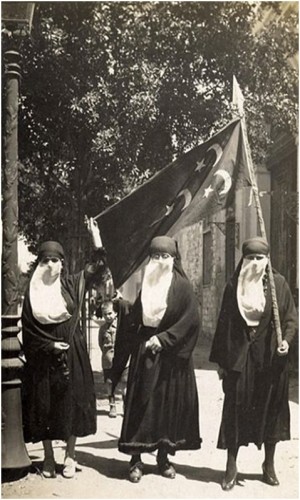
Egyptian women demonstrating in the 1919 revolution (courtesy of Wikipedia)
The function of the veil as a tool used by women in early twentieth century Egypt to enter into the public sphere is part of narrative that would recur in various forms over the course of the century. For example, in the aftermath of the 1979 Islamic revolution in Iran, mandatory hijab restricted women from appearing in public spaces unveiled but did not inhibit them from participating as active members of society. Rather than denouncing the veil merely as a garment of oppression, Iranian women used veiling as a means to reclaim access to public spaces that would otherwise be denied them. Journalist Elaine Sciolino points to the functionality of veiling for women in modern-day Iran:
bq. Iran’s women, being subtle and adaptable, came to think of the veil as something more complicated than just an imprisoning garment. For many women, the Islamic dress became a tool to be used to their advantage, a way into public spaces. It gave them the right to be present in public spaces-to work in offices, to attend college, to drive, to walk on the streets. The veil gives women the license to do things (Sciolino).
Returning to early twentieth century Iran, state sanctioned policy on women’s hijab was initiated as early as 1936 with Reza Shah’s controversial unveiling campaign or “Kashf-e Hejab.” In an attempt to accelerate the modernization process, Reza Shah passed a law that would require women to abandon public veiling and adopt a more ‘Westernized’ form of dress, in essence, flipping the laws on mandatory hijab that would be set into place half a century later. Regardless of ideology or era of implementation, these veiling and unveiling policies reveal an ongoing politicization of women’s bodies that would in effect become a point of collision between imported Western values and longstanding Islamic tradition. But to what degree did this politicization occur in cinema, and to what end? While neither Iran nor Egypt can speak on behalf of the social, political, and geographical complexities of the entire Middle East, their prominence in feature film production over the last century and their precarious relationships with the West provide an interesting starting point from which to examine women’s evolving roles in the cinema of the region. I will now turn to the advent of motion picture production in Iran and Egypt, focusing on early representations of women and veiling in the 1933 film Dokhtar-e Lor (The Lor Girl), by Iranian producers Abdul Hossein Sepenta and Ardeshi Irani, and the 1927 film Leila, produced by the Egyptian Actress Aziza Amir who also stars in the film.
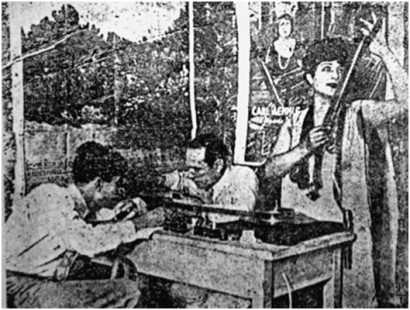
Ahmed al-Shari‘ai (the film financier/Amir’s husband), Istafan Rusti (director), and Aziza Amir (actress/producer) working in the editing suite. (From “I Have One Daughter and That Is Egyptian Cinema: Aziza Amir amid the Histories and Geographies of National Allegory” By Kay Dickinson)
While film production was introduced to Iran by way of the royal courts, it was fashioned into an organized business during the 1920s at a time of increasing advancements in the country’s infrastructure during Reza Shah’s reign. Along with the construction of railways, roads, schools and bridges, movie theaters began popping up in various cities with the help of a handful of entrepreneurs who were committed to seeing this new industry grow. Cinema owners and investors such as Ardeshir Khan and Ali Vakili established some of the first public cinemas in Iran and by the early 1930s there were approximately fifteen theaters in Tehran and eleven in other provinces with the numbers steadily increasing (Parhami).
With the establishment of the first film training center in Tehran by Armenian-Iranian Ovanes Ohanian, Iran’s first two silent feature films were produced and released to the public: Abi va Rabi (1929), which was patterned after the comic acts of the Danish duo Pat and Paterson and Haji Agha Aktor-e Cinema (Haji Agha the Cinema Actor, 1933), which was about a traditionalist who at first is suspicious of cinema but then recognizes it as an important form of art—a commentary on the disputes that might have arisen between traditionalists and modernists on the value of cinema in Iranian society at the turn of the century. While Abi va Rabi did well commercially, Haji Agha Aktor-e Cinema did not succeed at the box office due to its technical shortcomings and the fact that its release coincided with the first Persian talkie, Dokhtar-e Lor (The Lor Girl, 1933).
Co-produced and directed by Abdul Hossein Sepenta and Ardeshi Irani and starring Ruhangiz Sami-Nezhad in the role of Golnar, Dokhtar-e Lor was an instant success, so successful that the film played in theaters for two years following its initial release. The story is about a young girl named Golnar from the western province of Lorestan who is kidnapped by a band of thieves as a child. While performing in a coffee house, Golnar meets a security agent named Jafar who works for the newly formed central government. The two fall in love and plan to escape together to India. But the leader of the thieves, Gholi Khan, who wants to take Golnar as his wife, catches on to their plan and tries to prevent their escape. After several battle scenes between the security forces and the bandits, Jafar arrests Gholi Khan and his associates, restoring order to Iran and enabling Jafar and Golnar to marry.
The plot of Dokhtar-e Lor contains political undertones that present a commentary on the lawlessness of Iran during the end of Qajar rule and Reza Shah’s call to restore order in the land. As described by Mohammad Ali Issari in his account of early film production in Iran:
bq. When Reza Shah came to power in 1925, bandits still attacked caravans on the rugged mountain roads. Reza Shah’s first activities were to capture these local bandits, to strengthen the power of the central government, and to bring security to his people throughout the country (Issari 105).
Along with serving as a commentary on the social and political advancements made during the Pahlavi era, the film also brought an Iranian woman into the public eye in the first sound film ever produced by Iranian filmmakers. An intense search for an appropriate actress to play the part of Golnar preceded the producers’ final casting of Ruhangiz Sami-Nejad, the wife of one of the Iranian staff members of Imperial Film, the Bombay-based company which produced Dokhtar-e Lor. Although Sami-Nejad, who had never received any prior training in acting, was reluctant to take on the role, she was eventually convinced by the film’s producers Irani and Sepenta, who sold her on the fact that she would be the first Iranian woman in a motion picture produced for a Persian-speaking audience.
The film’s success was attributed to the fact that it was relatable to Iranians both in terms of its theme and language – Ruhangiz Sami-Nejad captured audiences’ attention with her fine performance and her endearing Kermani accent, which was to be imitated by fans of the film across the country (Issari 106). Additionally, Reza Shah’s 1932 banning of ta’zieh (passion plays) enacting Shiite themes and rituals meant that Iranians would have to find an alternate form of popular entertainment and this led them to turn to the movies. The film’s technical proficiency unlike Persian films produced years prior also added to its positive reception among critics and moviegoers.
Although Dokhtar-e Lor is no longer available in its entirety, a few scenes from the film are available online as well as in Mohsen Makhmalbaf’s 1992 film, Once Upon a Time Cinema, which was produced in part as an homage to the origins of Iranian cinema. [1] These scenes include the opening sequence of the film, one of the battle scenes in which Jafar fights Goli Khan while Golnar hangs from a rope off a cliff, and a scene where Golnar escapes the bandits by attacking one of them with a whip and riding off on his horse.
Approaching these scenes from a feminist perspective, one finds that the character of Golnar defies gender expectations of the time period in her appearance, actions and demeanor. The film’s opening scene sets the stage with Golnar as both subject and object of our gaze—she is literally placed center stage, performing a dance both for her diegetic audience in the coffee shop and her non-diegetic audience (ie. the film’s viewers). Already in her role as a performer, Golnar defies the traditional belief that women should stay on the sidelines and refrain from drawing the attention of male spectators. Golnar’s costume supports this characterization: her non-traditional veil, which consists of a small piece of cloth wrapped around her head like a bandana and her long braided hair that falls to her waistline run contrary to what was typically worn in public by Iranian women of the early twentieth century. The film’s omission of the chador, the full-length veil characteristically worn by women of that era, points to a cultural shift that had been taking place in the early 1930s and a move away from veiling that ultimately culminated in the unveiling act of 1936, three years after the release of Dokhtar-e Lor.
Of the few scenes that remain of the film, it is interesting to see how Golnar contends with various unfavorable circumstances—whether she is dangling from a cliff by a rope or threatened by a group of bandits who are out to kidnap her—the “damsel-in-distress” narrative is one that resembles The Perils of Pauline (Louis J. Gasnier, 1914), an American serial of the silent era in which a young woman with an adventurous spirit finds herself in trouble on more than one occasion and must either be rescued from imminent danger or find a way to rescue herself. One commentator describes Pauline in heroic terms, stating:
The daring, athletic and active female star performed some of the riskiest, hair-raising stunts in these films (stranded on the side of a cliff, in a runaway balloon, in a burning house, etc). Every second week in each new installment, Pauline (Pearl White) evaded attempts on her life –she fought pirates, Indians, gypsies, rats, sharks, rolling boulders, and her dastardly guardian” (Dirks).
In the case of Dokhtar-e Lor, Golnar, heroism is demonstrated along with defiance and resourcefulness, particularly in the face of her male captors—a statement that speaks to notions of female agency and power, which I am positing as an underlying feminist bent to the film’s “damsel-in-distress” narrative. In the scene in which Golnar confronts the bandits, one of them threatens to beat her, to which she angrily responds: “What? Beat me?!” As the bandit proceeds to bring over a whip, Golnar begins to plead “Please, please don’t beat me!” to the amusement of the bandits who relish in seeing her squirm. Golnar continues to plead as she cautiously moves away from the group of bandits and makes her way to the bandit holding the whip, who is standing next to a horse. As she begs and pleads, to his surprise and to the shock of the other bandits, she grabs the whip from his hands and begins whipping him relentlessly before laughing to herself in amusement, mounting his horse and riding off, effectively making her escape. Thus, Dokhtar-e Lor presents an interesting dichotomous illustration of a woman who is both captive and self-savior—while the story is based on the premise of her living a life of captivity until she meets Jafar, who represents the new order brought on by the formation of a centralized government, it also positions her in metaphoric terms whereby her self-liberation reflects Iran’s liberation from tribal rule.
The influence of Western forces in Iran during the time of the film’s production is important to mention, particularly when considering the extent to which the film supported Iran’s newly redefined image as a strong and unified country headed towards civil progress and cultural and economic modernity. While compared to the Qajars, Reza Shah’s independence from foreign powers was significant, his government continued to maintain economic dependency on the West during the 1930s, particularly Great Britain and Germany. In 1933, capital investment in Iran’s oil fields led to a series of negotiations that resulted in Reza Shah’s acceptance of revised concessions made to the Ango Persian Oil Company (APOC), allowing Great Britain to reap huge profits and continue paying low royalties, much to the disapproval of Iran’s nationalists (Keddie 101). In an attempt to reduce his country’s involvement with Great Britain, Reza Shah turned to Germany for economic and political support, complying with German agents at the onset of World War II—a move which ultimately led to his abdication in September of 1941 at the hands of allied forces. Nonetheless, as Nikki Keddie summarizes, “the years 1925 to 1941 [in which Reza Shah reigned] saw the partial fulfillment of a far larger modernization program than had ever been attempted in Iran” (Keddie 89) and it was during this time that cinema emerged as a voice that articulated the path that Iranians began taking together as a nation.
I will now move on to examine the birth of cinema in Egypt, which many would argue occurred with the 1927 silent film Leila directed by Wedad Orfi and Istifan Rusti and starring Egyptian actress and producer Aziza Amir. One film reviewer upon seeing the film proclaimed:
Silent acting has finally been born in Egypt. In the Egyptian sky a shining star has arisen, a star which seems to serve Egypt and the children of Egypt… which wants to carry out a great propaganda service…what is this propaganda which will serve the homeland in the greatest possible way? It is cinema…pure Egyptian cinema, national cinema… what is preventing us from having, within a few short years, a city like Hollywood? (Dickinson 137).
While the original film print is sadly no longer available and no duplication of it exists for viewing, film theorists and historians on Egyptian cinema recognize Amir’s achievement as one that was not only unique for its time but also set the premise for the rise and development of Egyptian cinema over years to come. Upon seeing the film at its premiere, Tal’at Harb, a nationalist financier and founder of the Misr Company for Cinema asserted that “[Asiza Amir] has achieved what men have failed to,” (Dickinson 138) which was to produce a film featuring an entirely Egyptian cast and subject matter and that would appeal to an Egyptian audience. While short films made prior were not considered as great achievements due to inconsistent subjects that were oftentimes non-relatable to Egyptians, they did provide experience to actors and technicians as well as prove to investors that films could be made in Egypt (Khan 18). Still, Amir is recognized as having made a seminal impact on the history of Egyptian cinema with Leila, a film which raises anti-colonial and pro-nationalist themes during a time of continued struggle for independence in Egypt.
The film’s narrative follows a young village girl named Leila, played by Amir, who gives herself to a Bedouin interpreter named Ahmed who in turn falls in love with an American women, much to Leila’s devastation. Ahmed and the American run off to the United States leaving Leila behind, pregnant. Abandoned by Ahmed, she is at the mercy of local villagers who eventually turn against her when her secret is revealed. Leila then sets off to Cairo where she seeks refuge from the turmoil she faced back in the village and the film concludes on a somber note with a recap of all the hardships Leila confronted since she met Ahmed.
There are a number of underlying themes from the plot summary alone that one could relate to the social and political situation in Egypt during the 1920s, when the country was still contending with British political, economic and administrative control, despite having established its independence in February 1922. A feminist reading of the narrative places the character of Leila in metaphoric terms, like Golnar, as representative of Egypt’s ongoing struggle between colonial rule (as personified by the American woman) and ongoing regressive cultural attitudes (as personified by the villagers), with Leila, like Egypt itself, being caught in the middle and left to deal with the detrimental outcome of these forces. Most of the plot summaries written about the film do not disclose whether Leila did in fact marry Ahmed before becoming pregnant with his child, but it is inferred that the child was conceived out of wedlock—a reference to the stigmatization women faced when failing to meet cultural expectations on marriage and childbearing that existed during those years.
Despite its bleak depiction of one woman’s struggle, Leila was produced during a time of significant advancement in Egypt’s feminist movement. The Egyptian Feminist Union (EFU) was established in 1923 and its monthly French-language periodical L’Egyptienne began publication in 1925, which targeted upper and upper-middle class readership in Egypt while also aiming to foster an international exchange on feminist issues among Western readers (Badran 102). During this time, Egyptian feminists began raising their concerns with how Egyptian women were being portrayed in the West in a negative and ‘backwards’ light. As the President of the EFU Huda Sha’rawi declared in a speech given at the American University in Cairo in 1929:
bq. We found it necessary to put before the eyes of the European public opinion a true picture of the Egyptian woman, one other than that presented by writers who have gathered a mass erroneous information on the Orient. The only way to attack this was to create a women’s journal in a European language (Badran 102).
Thus, L’Egyptienne’s creation coincided with cinema’s emergence as a tool that could be used to redefine Egypt’s national and cultural identity both in its own eyes and in the eyes of Western audiences. Part of this meant to abandon cultural practices, such as veiling, that were considered by some feminists to be antiquated and to reinforce a more modernized image of Egypt that was effectively modeled after Western standards of feminist progress.
Similarly, in cinema representations of women and veiling were increasingly fashioned after Hollywood pictures of that era, depicting stylized and even glamorized versions of women rarely seen wearing the veil, as this movie posters from the 1938 film Yahya el hub illustrates: [2]
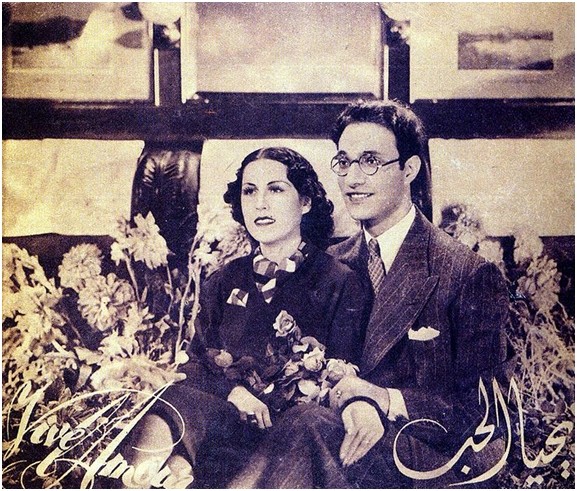
Movie poster of the Egyptian film Yahya el hub (1938) (courtesy of Wikipedia)
Aziza Amir, producer and star of Leila, continued her involvement in the film industry by participating in over twenty films before her death in 1952, sometimes taking on roles that entailed a more traditional appearance, but otherwise complying with the Westernized standards of dress that became the norm for actors and actresses of that era. It is interesting to point out that, along with adhering to Westernized standards of dress, Egyptian films adopted the same genres that had become popular in Hollywood cinema—notably song and dance films, melodramas and comedies. Egyptian cinema was progressively becoming an escapist form of entertainment: audiences expected strongly typed parts, love stories and happy endings—thus, narratives that had little to do with the everyday life of average Egyptians. With the exception of Kamal Selim and a handful of other directors interested in portraying socially relevant issues through film, Egyptian cinema of the 1930s and 1940s appeared to be largely colonized by Western genres and motifs not to mention representations of male and female characters. And while Leila posited some degree of reflection on the reality of women in Egypt and set the stage for filmmakers who wished to follow along that same path, Egyptian cinema of the interwar period by and large turned to Hollywood as a model for popular entertainment leaving little trace of Egyptian society as it actually was for audiences to reflect on.
Similarly, Iranian cinema struggled in its early years to find an image for itself that was separate from that which was propagated by foreign imports. Following the opening of Cinema Zardoshtian, which was the third cinema in Tehran to be established exclusively for women, an advertisement appeared in Ettela’at newspaper on May 11, 1928:
Two Simultaneous Pieces of Good News for the Respected Ladies
In Cinema Zardoshtian the showing of the famous Ruth Roland serials, the acclaimed world actress, will start for the respected ladies. Seeing the spectacular actions of a world-renowned talented girl (Ruth Roland) is a must for the ladies. Cinema Zardoshtian from today, 20 Ordibehesht, will give a free ticket to any lady with the purchase of one ticket (Issari 105).
Although this ad had been published prior to the emergence of sound film and the production of Dokhtar-e Lor, it demonstrates the appeal of American actresses such as Ruth Roland for female moviegoers in Iran who were new to film spectatorship. And while the period of 1937 to 1948 marked a decade of non-productivity in the history of Iranian cinema due to the occupation of allied forces and the domination of foreign films among other factors, the 1950s and 1960s saw a revival in domestic film production with commercialism being the foundation of its rebirth: “[Iranian cinema] was saturated with dominant themes of dance, music, simplistic dramas and Persianized versions of Western popular movies. But it also brought about the possibility of an independent national cinema” (Parhami).
In summary, I would argue that colonial infiltration in early motion picture production both in Iran and in Egypt served to create a model that commercial filmmakers of the early-to-mid twentieth century (and in the case of Iran, until the 1979 Islamic Revolution) would follow, positing dichotomous representations of both women and the national cinemas they helped characterize. And as both national cinemas began to expand (in the case of Egypt during WWII and in Iran’s case after the war), the role of women continued to expand as well, with more actresses and producers gaining recognition for their contributions to the film industry. The role of the veil in both Iranian and Egyptian cinema became progressively less relevant despite being an important part of the lives of Iranian and Egyptian women of certain classes and generations. This was perhaps a reflection of how veiling in cinema had become part of a larger discourse on national identity, one that complied with the image of modernity as it was understood during those years. Egyptian cinema theorist and historian Marisa Farrugia remarks:
In 1923, Zafiya Zaghul welcomed her husband, the Wafd party leader Sa’ad Zaghlul (d.1927) on his return from exile in Malta by lifting the veil that covered her face. The women who accompanied her did the same. This did not just mean that she adhered to the emancipation of women, but it symbolically meant the liberty of her nation. Five years later Aziza Amir stood in front of a camera for the first time. She was followed by Bahija Hafez, Fatima Rushdi, Amina Rizq, Assya Dagher, Munira al-Mahdiya, Mary Queeny and other female artists. They all pursued their careers in spite of the conservative ideas prohibiting women from appearing unveiled in public, let alone on the screen (Farrugia 97).
As Farrugia points out, the emergence of actresses in Egyptian cinema followed an awakening of sorts whereby unveiling and nationalism became the characteristics of a newly defined Egypt that by its appearance would emulate modernity as it had been seen in Western society and its cinema.
In Iran, the return of cinema after roughly a ten-year hiatus during the war began with the importation of foreign movies that were dubbed in Persian and shown to local audiences. Such films as Dokhtare Farari (Escaping Girl) produced in France and starring Danielle Darieux did quite well at the box office—thus beginning a trend for major studios in Tehran to dub films as a way to survive the period of scarcity in local productions (Issari 126). When the studios began producing films again in the late 1940s, audiences’ expectations towards the quality of films shown and to some degree their subject matters, raised the standards of production and led film content in new directions. As in Egypt, women’s roles in feature film production saw a steady increase—however, they participated more actively in front of the camera as actresses rather than behind it as producers or directors during this time period. Some of the actresses working in the film industry of this period include: Delkash, Shahla (who was also the first woman to produce and direct a feature film in Iran) and Faranak Mirghahari among others.
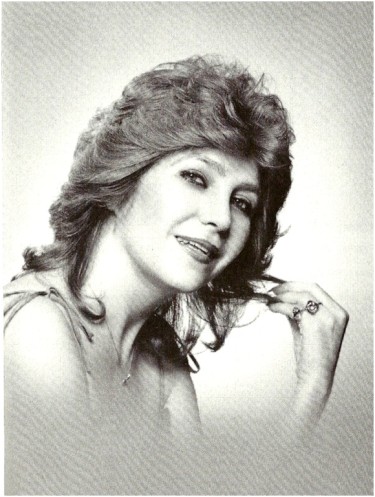
Iranian actress, Faranak Mirghahari (From Cinema in Iran 1900-1979 by Mohammad Ali Issari)
In both Egyptian and Iranian film industries, the veil became a relic of the past as more and more actresses emulated Hollywood and other Western film industries in their roles and appearances in film—perhaps an indication of moviegoers growing support of a new cultural identity posited by the cinema, which did not necessarily reflect issues relevant to contemporary Middle Eastern societies. Of the post World War II era, Mohammad Ali Issari remarks: “Escapist films [in Iran], aimed at the lowest standards of public taste, continued making strictly box-office-oriented films with very little or no artistic merit,” (Issari 147). While on the whole cinema during those years followed a consumer-oriented path, the future of film production in Iran would eventually give rise to such critically acclaimed voices as Forough Farrokhzad (The House is Black, 1962) and a host of other filmmakers that would emerge as part of the Iranian New Wave—a post-revolutionary movement which critics described as one of the world’s preeminent national cinemas. Women filmmakers like Rakhshan Bani-Etemad, Tahmineh Milani, Samira Makhmalbaf, and Pouran Derakhshandeh began using film as a tool to critically engage with contemporary social issues from a feminine perspective, at a time when the veil had reemerged as a political force to be contended with both onscreen and off.
However, the process of Islamization that occurred in Iranian cinema after the revolution did not appear in new Egyptian cinema, as Viola Shafik points out:
[Egyptian cinama] has remained on the ‘dark’ side of moral binarism. In particular the retreat and veiling of actresses during the early 1990s was able to confirm cinematic practices as being opposed to Islamist-defined piety. The representation of the female body as cut-out icon in combination with the invitation to direct gazing seem crucial in upholding this opposition. What can be confirmed is that Egyptian film has done a great deal to support unilateral male gazing (Shafik 170).
Unlike Iranian cinema, contemporary Egyptian cinema has remained loyal to narratives which represent women in overtly sexualized ways, with such classic typed parts as belly dancers making appearances in recent films like A Woman Bound to Fall_/_imra’a ‘ayyila li-l-suqut (1992) just as they did during the post war era of Egyptian filmmaking. But like Iranian cinema, the emergence of such women directors as Inas al-Dighidi have allowed for an alternative depiction of women with the production of films like Cheap Flesh_/_Lahm rachis (1995) and Night Talk_/_Kalam al-layl (1999) that posit new characterizations of women and their oftentimes dichotomous positions in contemporary Egyptian society.
Thus, the turn of the century marked a time of great promise for Iran, Egypt and other countries that were inching towards modernization and redefining their nationhood. Cinema emerged as a cultural voice that could effectively articulate these advancements while also redefining cultural and gender identities for both local and foreign audiences. Women played an instrumental role in the emergence of cinema as pioneers of the industry while also embodying cultural changes that could be located within the films being produced. Representations of women’s veiling, a practice that remained a prominent part of Egyptian and Iranian society in the early twentieth century, all but dissipated in the cinema by mid century, with films becoming seemingly more Westernized as decades passed, despite the countries’ aims to do away with colonial influence in the region. And while the face of cinema evolved to varying degrees in both Iranian and Egyptian film industries, with Iran’s film industry transforming more dramatically after the 1979 Islamic revolution, a constant thread that remains vital to the evolution of filmmaking in the region is the continued participation of women—whose roles in early feature film production, veiled or unveiled, served as a symbol of change that had only just begun.
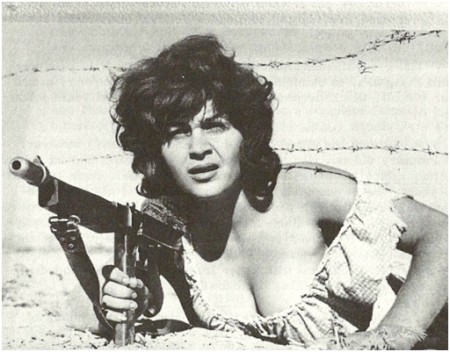
Faranak Mirghahari in Akharin Gozargah (The Last Hurdle) 1962 (From Cinema in Iran 1900-1979 by Mohammad Ali Issari)
Photo Credits:
Wikipeida photos sourced at Cinema of Egypt
Bibliography
Afary, Janet . The Iranian Constitutional Revolution, 1906-1911: Grassroots Democracy, Social Democracy, and the Origins of Feminism. New York: Columbia University Press, 1996.
Ali Issari, Mohammad. Cinema in Iran 1900-1979. Metuchen: The Scarecrow Press, 1989.
Badran, Margot. _Feminists, Islam, and Nation: Gender and the Making of Modern Egyp_t. Princeton: Princeton University Press, 1995.
Dickinson, Kay. “I Have One Daughter and That Is Egyptian Cinema: Aziza Amir amid the Histories and Geographies of National Allegory.” Camera Obscura 64, vol. 22, no. 1, 2007.
Dirks, Tim. “The Perils of Pauline (1914)”. Filmsite Movie Review.
Farrugia, Marisa. The Plight of Women in Egyptian cinema 1940s-1960s. PhD thesis published by University of Leeds, 2002.
Keddie, Nikki. Modern Iran: Roots and Results of a Revolution. New Haven: Yale University Press, 2006.
Khan, Mohamed. An Introduction to the Egyptian Cinema. London: Informatics, 1969.
Mahani, Najmeh Khalili. “Women of Iranian Popular Cinema: Projection of Progress.” Offscreen. Volume 10, Issue 7. July 31, 2006.
Naghibi, Nima. Rethinking Global Sisterhood: Western Feminism and Iran. Minnesota: University of Minnesota Press, 2007.
Parhami, Shahin. “Iranian Cinema: Before the Revolution.” Offscreen. December 1999.
Sciolino, Elaine. “Iran: Behind the Veil.” The Globalist. June 2001.
Shafik, Viola. Popular Egyptian Cinema. Cairo: The American University in Cairo Press, 2007.



_400_258_90_s_c1.jpg)
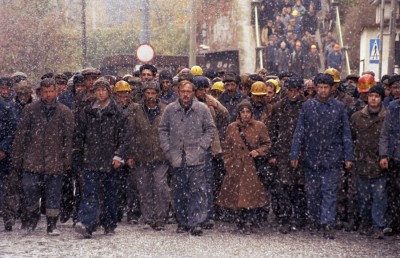
_400_258_90_s_c1.jpg)
